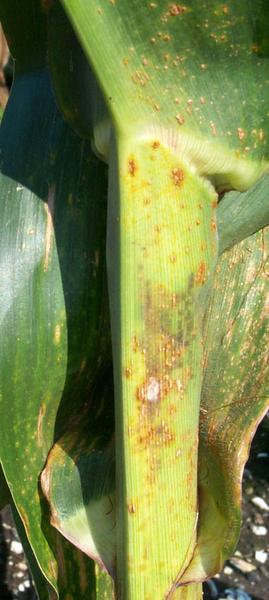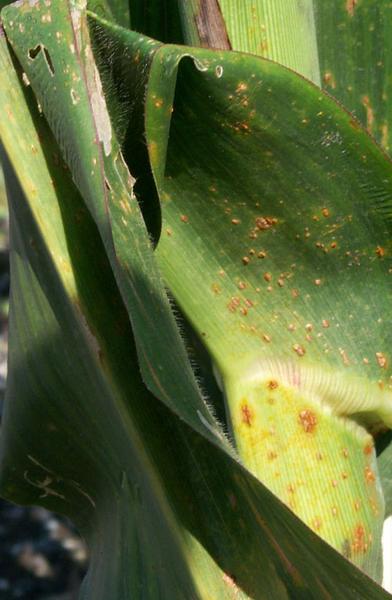Introduction
Rusts are fungal diseases that can be found throughout corn growing regions of the United States and southern Canada. Two kinds of rust can affect corn in North America: common rust and southern rust. Common rust, as the name implies, is more commonly observed, though it is significantly less destructive than southern rust. Southern corn rust, primarily found in the southern U.S., may be found in northern states experiencing particularly hot and humid years. Southern rust of corn is much more destructive than common rust, as it is able to develop and spread quickly.. Severe levels of rusts lead to reduced photosynthesis, weakened kernels, and yield losses.
Pathogen
Common rust is caused by the fungus, Puccinia sorghi. Southern rust is caused by the fungus, Puccinia polysora.
Symptoms
Common rust begins with lesions on leaves resembling flecks that develop into small, tan spots. These lesions will be found on both the upper and lower surfaces of the leaves or leaf sheaths and are scattered across the leaf surface. The lesions are circular to elongate and may occur in clusters. As lesions mature and grow in length, the fungus erupts through the epidermis of the leaf surface and a characteristic yellow halo is commonly present. Within the lesions, asexual spores (urediniospores) grow and create jagged, elongate, brick-red to cinnamon-brown pustules that can readily rub off onto fingers. As the disease progresses, the urediniospores produce dark, orange-brown teliospores, creating darker pustules.
Southern corn rust begins with small circular-to-oval shaped lesions often accompanied by a light green to yellow halo. Similarly to common rust, as lesions mature, they erupt through the epidermis of the leaf surface, but are almost exclusively located on the upper leaf surface. Within the lesions are light orange to cinnamon-red urediniospores that make up pustules early in the season. Southern rust pustules tend to be smaller, have a more circular shape, and are more densely packed than common rust pustules. Unlike common rust, the lesions not only develop on leaf tissues, but can also develop on the stalk, husk, and leaf sheath.
Disease Cycle
Urediniospores are the primary infective propagule in the U.S. and are spread via the wind. Spores will infect corn and cause symptoms within 3-4 days of infection. Within 7 to 14 days, more urediniospores are produced and new infections continue to occur while conditions are favorable, which can rapidly lead to an epidemic. As the growing season progresses, dark brown to black teliospores develop within the lesions. At times during the season both urediniospores and the teliospores can be present within lesions, eventually leading to only the darker teliospores.
For common rust, teliospores infect alternate hosts to complete its life cycle. The alternate hosts for common rust are several Oxalis spp. including creeping woodsorrel (Oxalis corniculata), common yellow woodsorrel (O. stricta), Bowie’s woodsorrel (O. bowiei), and O. conorrhiza. For Southern rust, the teliospores are not important for disease spread and development, and the alternate hosts are unknown. Disease development of Southern rust relies on urediniospores carried north from tropical regions.
Environmental Conditions for Disease
Common rust development is favored by cool, moist conditions. Optimal conditions for development are temperatures of 61-77°F (16-25°C) and at least 6 hours of concurrent dew. Southern rust prefers warmer temperatures of 77-88°F (25-31°C) and at least 4 hours of concurrent dew. While common rust can develop relatively early in the growing season, southern rust is more commonly seen later when temperatures are higher. If hot, dry conditions occur, development of rusts will be slowed or stop completely, and can be easily confused with diseases like gray leaf spot.
Management
Resistant Varieties
- The most cost-effective method for controlling common rust is using disease resistant hybrids, where available.
- Information for resistance to southern rust is limited.
Scouting
- Early and frequent scouting of fields are beneficial if corn rust is found nearby to prepare for potential fungicide applications.
- Keep track of disease progression, crop growth stage, and weather to inform management decisions on the necessity of a fungicide application.
Chemical Control
- For common rust, spray when 80% of leaves observed have one or more pustules. For Southern rust, spray when 50% of leaves observed have one or more pustules.
- If more than 1-2% of the leaf area is affected, spraying may increase yields.
- Fungicides are generally less effective in controlling Southern Rust and they must be applied at higher rates.
- Corn within two weeks of black layer is unlikely to benefit.
- Spraying corn with a yield potential of less than 100 bushels/ acre is unlikely to provide a profitable return.
- Cost of fungicide and application is likely to be $15.00 to $20.00/acre, thus a 10-bushel increase is needed to pay for treatment costs.
- For fungicide efficacy, see the fungicide efficacy table for corn created by the Corn Disease Working Group.
Useful Resources
- The NC State University Plant Disease and Insect Clinic provides diagnostics and control recommendations
- The NC State Extension Plant Pathology portal provides information on crop disease management
- The North Carolina Agricultural Chemicals Manual provides pesticide information for common diseases of North Carolina. The manual recommendations do not replace those described on the pesticide label, and the label must be followed.
- North Carolina Cooperative Extension also provides details on corn production in relation to southern rust
Publication date: Aug. 14, 2018
Reviewed/Revised: Sept. 27, 2023
N.C. Cooperative Extension prohibits discrimination and harassment regardless of age, color, disability, family and marital status, gender identity, national origin, political beliefs, race, religion, sex (including pregnancy), sexual orientation and veteran status.
NC Cooperative Extension prohíbe la discriminación por raza, color, nacionalidad, edad, sexo (incluyendo el embarazo), discapacidad, religión, orientación sexual, identidad de género, información genética, afiliación política, y estatus de veteran.
Recommendations for the use of agricultural chemicals are included in this publication as a convenience to the reader. The use of brand names and any mention or listing of commercial products or services in this publication does not imply endorsement by NC State University or N.C. A&T State University nor discrimination against similar products or services not mentioned. Individuals who use agricultural chemicals are responsible for ensuring that the intended use complies with current regulations and conforms to the product label. Be sure to obtain current information about usage regulations and examine a current product label before applying any chemical. For assistance, contact your local N.C. Cooperative Extension county center.
N.C. Cooperative Extension prohibits discrimination and harassment regardless of age, color, disability, family and marital status, gender identity, national origin, political beliefs, race, religion, sex (including pregnancy), sexual orientation and veteran status.


